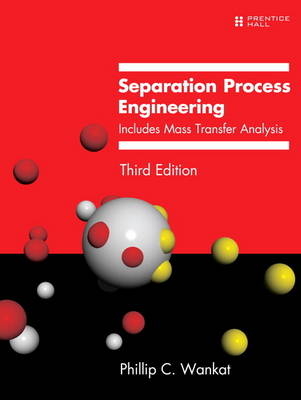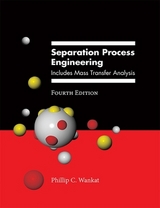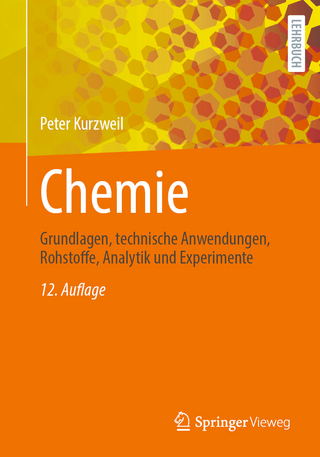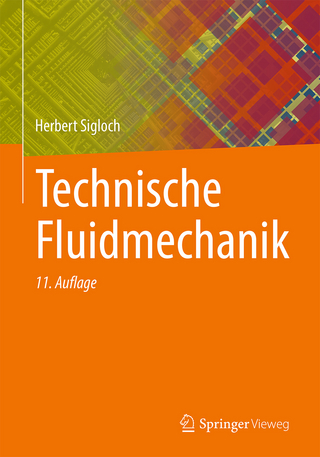
Separation Process Engineering
Prentice Hall (Verlag)
978-0-13-138227-5 (ISBN)
- Titel erscheint in neuer Auflage
- Artikel merken
Separation Process Engineering, Third Edition, is the most comprehensive, accessible guide available on modern separation processes and the fundamentals of mass transfer. Phillip C. Wankat teaches each key concept through detailed, realistic examples using real data–including up-to-date simulation practice and new spreadsheet-based exercises.
Wankat thoroughly covers each of today’s leading approaches, including flash, column, and batch distillation; exact calculations and shortcut methods for multicomponent distillation; staged and packed column design; absorption; stripping; and more. In this edition, he also presents the latest design methods for liquid-liquid extraction. This edition contains the most detailed coverage available of membrane separations and of sorption separations (adsorption, chromatography, and ion exchange).
Updated with new techniques and references throughout, Separation Process Engineering, Third Edition, also contains more than 300 new homework problems, each tested in the author’s Purdue University classes.
Coverage includes
Modular, up-to-date process simulation examples and homework problems, based on Aspen Plus and easily adaptable to any simulator
Extensive new coverage of mass transfer and diffusion, including both Fickian and Maxwell-Stefan approaches
Detailed discussions of liquid-liquid extraction, including McCabe-Thiele, triangle and computer simulation analyses; mixer-settler design; Karr columns; and related mass transfer analyses
Thorough introductions to adsorption, chromatography, and ion exchange–designed to prepare students for advanced work in these areas
Complete coverage of membrane separations, including gas permeation, reverse osmosis, ultrafiltration, pervaporation, and key applications
A full chapter on economics and energy conservation in distillation
Excel spreadsheets offering additional practice with problems in distillation, diffusion, mass transfer, and membrane separation
Phillip C. Wankat is Clifton L. Lovell Distinguished Professor of Chemical Engineering and director of undergraduate degree programs at Purdue University’s School of Engineering Education. His current research interests include adsorption, large-scale chromatography, simulated moving bed systems, and distillation, as well as improvements in engineering education. He received the 2007 Distinguished Education Alumni Award of Distinction from Purdue’s College of Education, and the 2005 Shreve Prize in Chemical Engineering. With K. S. Knaebel, he contributed the Mass Transfer section to Perry’s Handbook of Chemical Engineering, Eighth Edition (McGraw-Hill, 2008).
Preface xvii Acknowledgments xix
About the Author xxi
Nomenclature xxiii
Chapter 1: Introduction to Separation Process Engineering 1
1.1. Importance of Separations 1
1.2. Concept of Equilibrium 2
1.3. Mass Transfer 4
1.4. Problem-Solving Methods 5
1.5. Prerequisite Material 7
1.6. Other Resources on Separation Process Engineering 7
1.7. Summary–Objectives 10
References 10
Homework 11
Chapter 2: Flash Distillation 13
2.1. Basic Method of Flash Distillation 13
2.2. Form and Sources of Equilibrium Data 15
2.3. Graphical Representation of Binary VLE 18
2.4. Binary Flash Distillation 22
2.5. Multicomponent VLE 30
2.6. Multicomponent Flash Distillation 34
2.7. Simultaneous Multicomponent Convergence 42
2.8. Three-Phase Flash Calculations 47
2.9. Size Calculation 48
2.10. Utilizing Existing Flash Drums 53
2.11. Summary–Objectives 54
References 54
Homework 56
Appendix A. Computer Simulation of Flash Distillation 67
Appendix B. Spreadsheets for Flash Distillation 73
Chapter 3: Introduction to Column Distillation 79
3.1. Developing a Distillation Cascade 79
3.2. Distillation Equipment 86
3.3. Specifications 88
3.4. External Column Balances 91
3.5. Summary–Objectives 95
References 95
Homework 95
Chapter 4: Column Distillation: Internal Stage-by-Stage Balances 101
4.1. Internal Balances 101
4.2. Binary Stage-by-Stage Solution Methods 105
4.3. Introduction to the McCabe-Thiele Method 112
4.4. Feed Line 116
4.5. Complete McCabe-Thiele Method 124
4.6. Profiles for Binary Distillation 127
4.7. Open Steam Heating 129
4.8. General McCabe-Thiele Analysis Procedure 134
4.9. Other Distillation Column Situations 140
4.10. Limiting Operating Conditions 146
4.11. Efficiencies 148
4.12. Simulation Problems 150
4.13. New Uses for Old Columns 151
4.14. Subcooled Reflux and Superheated Boilup 153
4.15. Comparisons between Analytical and Graphical Methods 155
4.16. Summary–Objectives 156
References 158
Homework 159
Appendix A. Computer Simulations for Binary Distillation 173
Appendix B. Spreadsheets for Binary Binary Distillation 177
Chapter 5: Introduction to Multicomponent Distillation 183
5.1. Calculational Difficulties 183
5.2. Stage-By-Stage Calculations for Constant Molal Overflow and Constant Relative Volatility 189
5.3. Profiles for Multicomponent Distillation 193
5.4. Bubble-Point and Dew-Point Equilibrium Calculations 198
5.3. Summary–Objectives 203
References 203
Homework 203
Appendix. Spreadsheet Calculations for Ternary Distillation with Constant Relative Volatility 209
Chapter 6: Exact Calculation Procedures for Multicomponent Distillation 215
6.1. Introduction to Matrix Solution for Multicomponent Distillation 215
6.2. Component Mass Balances in Matrix Form 217
6.3. Initial Guesses for Flow Rates and Temperatures 220
6.4. Temperature Convergence 221
6.5. Energy Balances in Matrix Form 224
6.6. Introduction to Naphtali-Sandholm Simultaneous Convergence Method 227
6.7. Discussion 229
6.8. Summary–Objectives 230
References 230
Homework 230
Appendix. Computer Simulations for Multicomponent Column Distillation 237
Chapter 7: Approximate Shortcut Methods for Multicomponent Distillation 243
7.1. Total Reflux: Fenske Equation 243
7.2. Minimum Reflux: Underwood Equations 248
7.3. Gilliland Correlation for Number of Stages at Finite Reflux Ratio 253
7.4. Summary–Objectives 257
References 257
Homework 258
Chapter 8: Introduction to Complex Distillation Methods 265
8.1. Breaking Azeotropes with Other Separators 265
8.2. Binary Heterogeneous Azeotropic Distillation Processes 266
8.3. Steam Distillation 275
8.4. Two-Pressure Distillation Processes 279
8.5. Complex Ternary Distillation Systems 281
8.6. Extractive Distillation 290
8.7. Azeotropic Distillation with Added Solvent 296
8.8. Distillation with Chemical Reaction 300
8.9. Summary–Objectives 303
References 304
Homework 305
Appendix. Simulation of Complex Distillation Systems 321
Chapter 9: Batch Distillation 329
9.1. Binary Batch Distillation: Rayleigh Equation 331
9.2. Simple Binary Batch Distillation 332
9.3. Constant-Level Batch Distillation 336
9.4. Batch Steam Distillation 337
9.5. Multistage Batch Distillation 340
9.6. Operating Time 344
9.7. Summary–Objectives 346
References 347
Homework 347
Chapter 10: Staged and Packed Column Design 357
10.1. Staged Column Equipment Description 357
10.2. Tray Efficiencies 365
10.3. Column Diameter Calculations 370
10.4. Balancing Calculated Diameters 376
10.5. Sieve Tray Layout and Tray Hydraulics 378
10.6. Valve Tray Design 386
10.7. Introduction to Packed Column Design 388
10.8. Packed Column Internals 388
10.9. Height of Packing: HETP Method 390
10.10. Packed Column Flooding and Diameter Calculation 392
10.11. Economic Trade-Offs for Packed Columns 400
10.12. Choice of Column Type 401
10.13. Summary–Objectives 404
References 405
Homework 408
Appendix. Tray And Downcomer Design with Computer Simulator 416
Chapter 11: Economics and Energy Conservation in Distillation 419
11.1. Distillation Costs 419
11.2. Operating Effects on Costs 425
11.3. Changes in Plant Operating Rates 432
11.4. Energy Conservation in Distillation 433
11.5. Synthesis of Column Sequences for Almost Ideal Multicomponent Distillation 437
11.6. Synthesis of Distillation Systems for Nonideal Ternary Systems 442
11.7. Summary–Objectives 447
References 447
Homework 449
Chapter 12: Absorption and Stripping 455
12.1. Absorption and Stripping Equilibria 457
12.2. McCabe-Thiele Solution for Dilute Absorption 459
12.3. Stripping Analysis for Dilute Systems 462
12.4. Analytical Solution for Dilute Systems: Kremser Equation 463
12.5. Efficiencies 469
12.6. McCabe-Thiele Analysis for More Concentrated Systems 470
12.7. Column Diameter 474
12.8. Dilute Multisolute Absorbers and Strippers 476
12.9. Matrix Solution for Concentrated Absorbers and Strippers 478
12.10. Irreversible Absorption and Co-Current Cascades 482
12.11. Summary–Objectives 484
References 484
Homework 485
Appendix. Computer Simulations for Absorption and Stripping 494
Chapter 13: Liquid-Liquid Extraction 499
13.1. Extraction Processes and Equipment 499
13.2. Countercurrent Extraction 503
13.3. Dilute Fractional Extraction 511
13.4. Immiscible Single-Stage and Cross-Flow Extraction 515
13.5. Concentrated Immiscible Extraction 519
13.6. Immiscible Batch Extraction 520
13.7. Extraction Equilibrium for Partially Miscible Ternary Systems 522
13.8. Mixing Calculations and the Lever-Arm Rule 524
13.9. Partially Miscible Single-Stage and Cross-Flow Systems 528
13.10. Countercurrent Extraction Cascades for Partially Miscible Systems 531
13.11. Relationship between McCabe-Thiele and Triangular Diagrams for Partially Miscible Systems 539
13.12. Minimum Solvent Rate for Partially Miscible Systems 540
13.13. Extraction Computer Simulations 542
13.14. Design of Mixer-Settlers 543
13.15. Introduction to Design of Reciprocating-Plate (Karr) Columns 557
13.16. Summary–Objectives 558
References 559
Homework 561
Appendix. Computer Simulation of Extraction 572
Chapter 14: Washing, Leaching, and Supercritical Extraction 575
14.1. Generalized McCabe-Thiele and Kremser Procedures 575
14.2. Washing 576
14.3. Leaching with Constant Flow Rates 582
14.4. Leaching with Variable Flow Rates 584
14.5. Supercritical Fluid Extraction 587
14.6. Application to Other Separations 590
14.7. Summary–Objectives 590
References 590
Homework 591
Chapter 15: Introduction to Diffusion and Mass Transfer 599
15.1. Molecular Movement Leads to Mass Transfer 600
15.2. Fickian Model of Diffusivity 602
15.3. Values and Correlations for Fickian Binary Diffusivities 616
15.4. Linear Driving-Force Model of Mass Transfer for Binary Systems 622
15.5. Correlations for Mass-Transfer Coefficients 628
15.6. Difficulties with Fickian Diffusion Model 640
15.7. Maxwell-Stefan Model of Diffusion and Mass Transfer 641
15.8. Advantages and Disadvantages of Different Diffusion and Mass-Transfer Models 655
15.9. Summary—Objectives 655
References 656
Homework 657
Appendix. Spreadsheet for Example 15-6 661
Chapter 16: Mass Transfer Analysis for Distillation, Absorption, Stripping, and Extraction 663
16.1. HTU-NTU Analysis of Packed Distillation Columns 663
16.2. Relationship of HETP and HTU 673
16.3. Mass Transfer Correlations for Packed Towers 675
16.4. HTU-NTU Analysis of Absorbers and Strippers 683
16.5. HTU-NTU Analysis of Co-Current Absorbers 688
16.6. Prediction of Distillation Tray Efficiency 690
16.7. Mass-Transfer Analysis of Extraction 693
16.8. Rate-Based Analysis of Distillation 708
16.9. Summary–Objectives 712
References 713
Homework 714
Appendix. Computer Rate-Based Simulation of Distillation 721
Chapter 17: Introduction to Membrane Separation Processes 725
17.1. Membrane Separation Equipment 727
17.2. Membrane Concepts 731
17.3. Gas Permeation 733
17.4. Reverse Osmosis 749
17.5. Ultrafiltration (UF) 765
17.6. Pervaporation (PERVAP) 771
17.7. Bulk Flow Pattern Effects 781
17.8. Summary–Objectives 788
References 788
Homework 790
Appendix. Spreadsheets for Flow Pattern Calculations for Gas Permeation 798
Chapter 18: Introduction to Adsorption, Chromatography, and Ion Exchange 805
18.1. Sorbents and Sorption Equilibrium 806
18.2. Solute Movement Analysis for Linear Systems: Basics and Applications to Chromatography 819
18.3. Solute Movement Analysis for Linear Systems: Thermal and Pressure Swing Adsorption and Simulated Moving Beds 828
18.4. Nonlinear Solute Movement Analysis 851
18.6. Mass and Energy Transfer in Packed Beds 870
18.7. Mass Transfer Solutions for Linear Systems 877
18.8. LUB Approach for Nonlinear Systems 886
18.9. Checklist for Practical Design and Operation 890
18.10. Summary–Objectives 892
References 892
Homework 895
Appendix. Introduction to the Aspen Chromatography Simulator 909
Appendix A: Aspen Plus Troubleshooting Guide for Separations 915
Appendix B: Instructions for Fitting VLE and LLE Data with Aspen Plus 919
Appendix C: Unit Conversions and Physical Constants 921
Appendix D:Data Locations 923
Answers to Selected Problems 931
Index 939
| Erscheint lt. Verlag | 17.11.2011 |
|---|---|
| Verlagsort | Upper Saddle River |
| Sprache | englisch |
| Maße | 181 x 238 mm |
| Gewicht | 1342 g |
| Themenwelt | Naturwissenschaften ► Chemie ► Technische Chemie |
| Technik ► Umwelttechnik / Biotechnologie | |
| ISBN-10 | 0-13-138227-6 / 0131382276 |
| ISBN-13 | 978-0-13-138227-5 / 9780131382275 |
| Zustand | Neuware |
| Informationen gemäß Produktsicherheitsverordnung (GPSR) | |
| Haben Sie eine Frage zum Produkt? |
aus dem Bereich



